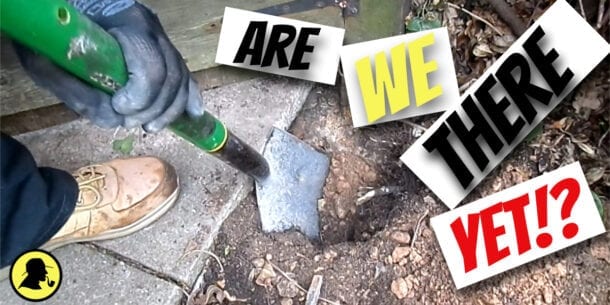The most common question searched on google when installing a fence is how deep should fence posts be in the ground?
well, it all depends on many factors, such as the length and width of the posts, size of fence panel they are adjoining too, and the material, whether it’s wood or concrete.
But that sounds too complicated, instead, my advice (and it has never let me down) is to make sure the hole is at least 3 times the width of the post to be installed and the depth, a 1/3 to a 1/2 of the posts height above ground level.

So to find a 1/3 you would just divide the desired post height above ground by 3 (i.e a 6ft post height divided by 3 would equal 2, so a 2 foot hole would need to be dug).
…And a half, well that’s easy, just half the desired post height.
How Deep Should a Concrete Fence Post Be In The Ground?
Concrete fence posts are slightly different, still keep with the hole width of 3 times the width of the post, but the depth needs to be at LEAST 2 foot.
In some instances upto 3 foot would be absolutely perfect.
The reason the holes have to be deeper for concrete, is because of the sheer weight of the posts.
Should Fence Posts Be Set In Concrete?
In short yes.
Concrete gives the post maximum stability and quickness (when using a fast setting concrete mix like Postcrete) when erecting a new fence or repairing a post.
But, bear in mind its not the best.
What Is The Best Concrete Mix For Fence Posts?
The best mix for concrete when installing fence posts is a mixture of 1 part cement, 2 parts sand and 3 parts aggregate (stone).
Mixing concrete in a cement mixer ensures all the cement,sand and aggregate mix evenly together.
But if it’s a small job, hand mixing in a wheel barrow will be more than adequate.
The only problem using a traditional concrete mix is that it can take a good day to to set, sometimes 2 days.
This becomes an issue when you need quickness of repair, especially in the winter or doing a fence/post repair for a customer.
‘ALL HAIL POSTCRETE’!
I’ve mentioned postcrete a few times already and there is a good reason why…It sets really fast!
Add some aggregate (optional) to the postcrete and you have an extremely strong repair which will be set in just 10 minutes!
How Long Will a Fence Post Last In The Ground?
Concrete fence posts have a life expectancy of about 25 years with minimal maintenance, but they aren’t immune to wear and tear. Over time rain and wind will eat away at them causing cracks and chips.
Wooden posts vary, from 5 years to 20 years, But it all boils down to how they were installed and maintained.
Don’t let 5 years put you off from installing a wooden post. The reason I say 5 years, is because many new build houses have their fences (literally) chucked up.
Wooden fence posts should have the correct hole size and depth, stones placed at the bottom of the hole for drainage and a slopped concrete edge troweled around the base of the fence post. This keep rotting down to a minimum. New build houses rarely see these processes followed.
What Is The Best Timber For Fence Posts?
The most common species of wood grown in the UK are Larch, Douglas fir, Pine and Spruce (a white wood).

These are all known as ‘Redwoods’
And should be your choice due to how easy the preservatives seem to penetrate deep into the timber.
Also, if you can look for wood labeled air dried (quite rare) then you know that the preservatives they’ve added have gone really deep into the timber.
You will see alot in DIY/Hardware stores the label ‘Kiln dried’.
Kiln dried means the wood has been dried out in a oven before treatment.
It is a quicker process than air dried (to keep up with supply and demand) but still allows the preservatives to go pretty deep in the timber, but the result of the fast drying usually results in brittle timbers.
In short, choose Redwood, kiln dried or air dried (if you can) and treated.
Are Concrete Fence Posts Better Than Wood?
Concrete fence posts are indeed better than wood for last ability, and they easily pay for themselves over time.

They will not rot or decay like wood can but they do have two important negativity’s for alot of people, and that’s price and environmental impact.
You will easily be paying 75% more than you do for a wooden post, also repairs are more expensive too.
One person isn’t going to heal the world but personally when you feel your doing your part for the environment it gives you a sense of pride and care.
And did you know…
It is important to realise that 5% of the worldwide generation of CO2 is due to cement production. (taken from Greenspec.co.uk)
Wood is always my choice, I think concrete looks ugly over time, and when painting fence panels the concrete always gets splashed, then trying to clean the paint off can be a right pain.
Did This Post Help?
Hopefully your not pulling your hair out anymore when it comes to finding how deep should fence posts be in the ground?
Stick to what I’ve said and your fence will be up in no time!
If your still unsure about anything regarding the depth of a fence post hole, let me know in the comments section below.
Each and every week I put my heart and soul into providing you with great content to help with any DIY jobs around the home.
If you think this post could help someone you know, please share.
Other Helpful Maintenance Articles
How To Maintain Your House – The Spring Home Maintenance Checklist With spring around the corner it makes perfect sense to check what maintenance your house may need for the season and the coming months ahead
What Does Spider Poop Look Like? Ever wondered what those little brown and black spots are in the corners of your room? It will make your skin crawl when you find out.
How To Paint Over Wallpaper, Is It Easy? How to paint over wallpaper is a simple process but there are steps you shouldn’t skip, find out what they are…


